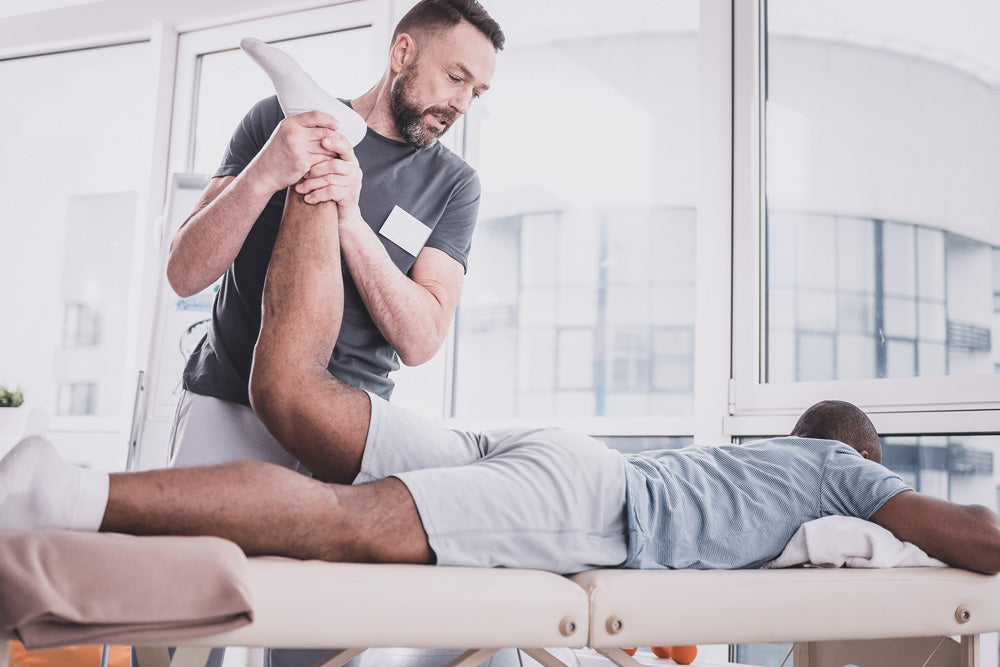
Pain Management Exercises You Can Try Today
For many people suffering from back or joint pain, the first instinct is to seek rest and avoid any activity that may aggravate that pain.
And for a long time within Irish medical circles, this was widely accepted as the remedy for pain (alongside pain medication) Doctors would prescribe extra hours of time in bed for their patients.
But is this still the case? Or should it be?
The HSE's 'Lets Get Active' guidelines for 2021 (PDF) list a lot of benefits of physical therapy; these guidelines help reduce the risk of developing cardiovascular diseases, obesity, metabolic diseases, and some cancers. It improves your mood and overall mental health, it strengthens your bones and muscles and makes it easier to go about your daily activities.
However, these ‘perks’ are stereotypically attributed to a physically and mentally healthy individual. This is why many people find it odd when a patient is prescribed exercise therapy, especially to manage pain.
Using an exercise programme for pain management seems to go against the very logic of reducing pain. But on the contrary, it can play a crucial role in alleviating some chronic pain symptoms.
For many years, Irish GPs and physicians have been advising patients experiencing chronic pain to find simple ways to remain active and avoid excessive bed rest - and we're here to help build upon this advice and give you some practical tips for when you're on your own, personal journey towards a healthier, happier pain-free existence.
How Does Exercise Help Manage Pain?
There are a couple of ways regular exercise can help you manage pain, the main one being that physical activity releases endorphins. Endorphins are neurochemicals that often elicit a “feel good” feeling, especially after a good workout session.
Endorphins are natural pain relievers - their name is a combination of the word endogenous (from within the body) and morphine (an opiate pain reliever). When released, they act on your brain’s opiate receptors, reducing pain and boosting pleasure. This is the main reason why exercise is prescribed in patients experiencing pain - it stimulates the production of endorphins, releasing a natural pain and stress reliever.
So you will not only feel less pain but also look forward to experiencing better sleep, something that patients with chronic pain can have a hard time achieving.
The benefits of exercise when recovering from or treating pain include the following:
Exercise keeps your muscles strong
This is especially helpful for patients experiencing chronic back pain. In this state, your spine needs as much help as it can get to support your weight and cushion your movements. Having strong muscles provides that extra support, allowing your spine to work less and ultimately reduce the discomfort.
On the other hand, rarely used muscles tend to deteriorate over time and stay in bad shape.
This is why choosing not to partake in any exercise programme in favour of bed rest is discouraged. While rest days are vital to your recovery, if you spend too much time resting, your muscles can become less effective. In addition your spine or joints may not get the help needed to support your weight which results in further worsening the pain. This can potentially trap you in a prolonged cycle of pain and medication.
It helps maintain a healthy body weight
Another way that too much rest traps a chronic pain patient in a cycle of endless pain is through unhealthy weight loss or gain. Gaining extra weight exerts more pressure on your spine, which can worsen your low back pain symptoms. As such, making healthy nutritional choices and using exercises to maintain a healthy weight range makes your road to recovery significantly easier.
It strengthens your joints
Like muscles, unused joints tend to weaken over time, a situation that will only hinder your recovery process.
Having an exercise regime that incorporates a blended range of motion and agility will help to loosen stiff muscles, build resistance in weak joints and develop better flexibility in tight tendons. This is necessary to keep your joints in good condition.
It helps with your mental health
It is incredibly common for those suffering from pain to develop issues with mental health, unsurprisingly a hindrance to your ability to partake in your regular routine and activities that you enjoy can affect your mood. In some cases morbid feelings of uselessness and/or anxiety may develop in such situations and ultimately lead to depression.
So, what’s the best way to avoid this? Stay active! Exercise is a good way to motivate yourself from a stressful situation. You will be actively engaged in something to fight your pain, which is an excellent way to boost your self-esteem. There is also the endorphin effect of exercising; an effective mood booster and stress reliever.
Another way that staying active helps mental health is the social aspect of exercise. The social benefits of going for a jog with friends, getting a gym membership, or joining a yoga class will help you connect to others also engaging in the activity and to stay connected to a community.
Now that we’ve established how therapeutic exercise can encourage pain relief let us look at the exercise types suitable for patients experiencing chronic pain symptoms.
Exercise Programmes
Here is a quick look at some of the types of exercises your physical therapist may recommend. This will depend on your pain levels being experienced, the type of pain you're suffering from, your stage of recovery and indeed, your fitness levels.
Stretching Exercises
Stretching is a simple flexibility exercise and is, for the most part, equipment-free. You can also do it almost anywhere.
When done right, stretching relieves tension and stiffness in the lower back and neck. This reduces lower back pain and improves the overall mobility of your neck and back.
Some simple upper body and lower body stretching exercises include:
- The hamstring stretch - a great warm-up exercise to loosen leg muscles
- Lumbar rolls - improves blood flow to lower back muscles
- The side bend - stretches your obliques ( your side abdominals) and spine
- The hip flexor and quad stretch - increases flexibility and range of motion of the thighs and abdominal muscles.
- The flute stretch (or 'knee hug) - works gluteal and lower back muscles
- The hip opener - activates hip muscles and improves full-body flexibility
Of course, there are countless other fantastic stretching exercises, but these stretches can be performed with relative ease while in your living room without the need for any equipment.
Yoga
Yoga has been around for thousands of years, and to say that its health benefits are plentiful would be an understatement.
By combining elements of meditation, measured breathing and gentle postures, this gentle relaxation exercise reduces symptoms of joint and back pain.
The meditative aspects of yoga can also help with any emotional trauma accompanying physical pain.
Cardio Exercises
Like stretching, cardiovascular exercises often require little or no equipment and there are many different formats suited to activity level and body mechanics.
The simplest and most common cardio exercises here in Ireland include the following staples.
Walking
Walks may not seem like much, but they make for an excellent way to gently exercise your joints. This reduces stiffness and offers pain relief, all while boosting energy levels and supplying oxygen to your muscles.
Walking helps with back pain and has been shown to improve fibromyalgia symptoms. Three half-hour walks a week are a great place to start. From here, you can improve the frequency and distance covered as your condition improves.
Swimming
Swimming is a great alternative for those who wish to include some fun in their light cardio exercises. Unlike walking, swimming keeps you moving while exerting little to no stress on your joints and muscles. This makes it the ideal gentle exercise for people with mobility issues.
The perks of swimming extend far beyond physical health. Swimming is therapeutic to many people and is a great way to relieve stress. Sea swimming (while remaining safe) can be an excellent way to also connect to nature and get those endorphins flowing.
Cycling
Cycling is a great aerobic exercise excellent for warming up the muscles and joints and is low impact. However, it is a little more demanding than swimming and walking.
Therefore, if you're suffering from pain of any sort, it's advised to only cycle in short bursts with rests in between rather than attempting long stretches. This will have the same health benefit as cycling long distances, but without exerting too much stress on your joints and muscles.
Water Aerobics
Swimming in itself is great, but have you thought about actually exercising in water? Not just any water, but warm water.
Performing aerobic exercises in warm water is a good way to relieve the pressure on your joints and relax the muscles. Cold water is generally frowned upon for chronic pain recovery as it can make the muscles tense, resulting in a potentially uncomfortable exercise session.
Pilates
Core strengthening exercises may seem a little complicated, but they are pretty effective in managing back pain. They help strengthen your core, at least the back part of it, and this study found that the simple movements of Pilates focus specifically on back alignment. But why is strengthening the core important for people with chronic pain?
Building a strong core helps you maintain a proper posture and balance, which reduces the risk of future injuries that may result in more pain.
And although using Pilates is beneficial to patients suffering from chronic back pain conditions such as sciatic nerve pain, care must be taken to do the movements correctly or the discomfort can worsen.
It’s recommended that you engage with a professional instructor and explain your pain issues, this means they will be able to tailor a sequence to suit your particular case.
Weight lifting
If you are seeking pain relief, the last thing you want is someone recommending lifting heavy objects - or is it? As we’ve established, building core strength is crucial to stabilising your joints and muscles, and one of the best exercises for this is weight lifting as part of a supervised, prescribed strength training programme.
It can sound pretty daunting at first, with a fear that it may make pain worse, but weight lifting done right will strengthen your core muscles and mitigate stress around the affected joints.
Simple daily activities
Last but not least, is engaging in the simple everyday activities around the home. If going to the gym for exercise is a little too much, daily chores will help. Do the laundry and dishes, cook or try cleaning the house. You don’t have to do everything, though, a healthy dose of exercise should help reduce your pain levels and improve your overall quality of life.
The Meaghers Verdict on Pain Managment
Exercise may be the last thing on your mind when experiencing chronic pain, but it can be very helpful. Exercises that incorporate simple movements, like walking, swimming, cycling, stretching, and yoga, are a great first step towards improving your core strength and building a natural resistance to pain. You can transition to more demanding ones like Pilates and weight lifting with time.
What works for you may not work for someone else, and thus, you need to consult a physician before starting your exercise program.
As much as we’re proponents of measured, regular exercise in pain patients, we must stress the potential risks involved too - these exercises can easily worsen your symptoms as they can better them, so you need medical advice before beginning.
Contact Us to Discuss Your Pain Management Requirements
If you’ve got a question for our pain specialists on the topic of pain management exercises, nutrition or any of the pain relief solutions or medications available in-store or on our website, please contact us today and we’d be delighted to assist and provide you with more advice and support to help you make more informed exercise choices.







